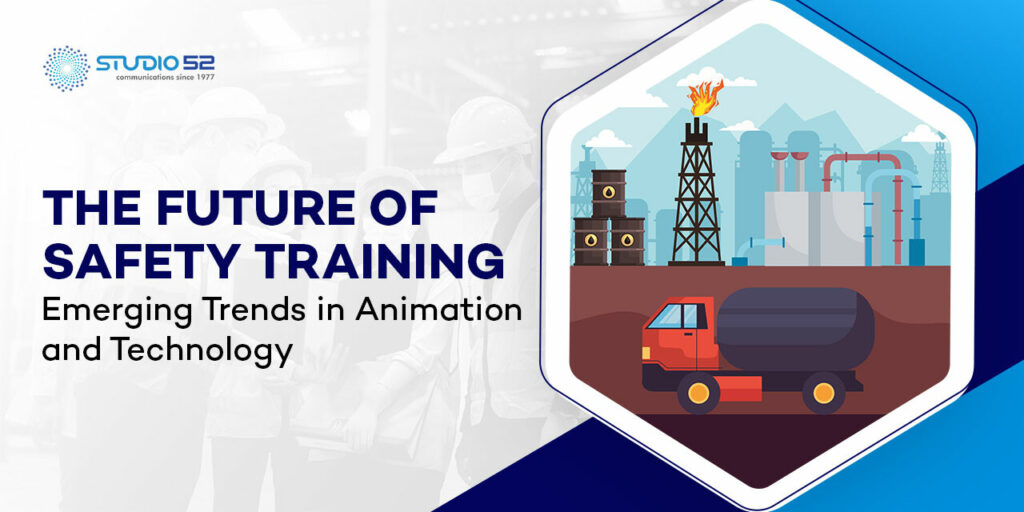From construction sites to healthcare environments, effective safety training ensures that employees are well-prepared to handle hazardous situations. Traditionally, this information was delivered through manuals, in-person sessions, and static videos. However, as technology evolves, so does the way organisations train their workforce.
Today, safety animation videos and other technological advancements are transforming the way safety knowledge is delivered — making safety training more engaging, memorable, and accessible.
This article explores the emerging trends in safety training, focusing on how animation and cutting-edge technology are shaping the future of workplace safety training.
Table of Content
1. The Evolution of Safety Training
As mentioned, traditional methods, while informative, often fail to engage employees fully. Manuals could be dry and difficult to understand, with content that is often too rigid and lacks interactivity.
One of the major challenges with traditional safety training is that it doesn’t always resonate with learners. And it all leads to poor retention. Additionally, inconsistencies in how information is presented by different trainers can result in knowledge gaps.
As workplace hazards continue to evolve, safety training must also advance to address these concerns.
Animated safety videos offer a more dynamic, visually engaging solution to traditional safety training methods. Simply put, animation provides the opportunity to depict complex topics in a more comprehensive way, making the training more accessible to workers of all backgrounds.
Interested in reading more? Then find out all about the benefits of safety animation videos.
2. The Role of Animation in Modern Safety Training
Animation is more than just a tool for entertainment. It has become a powerful medium for conveying critical information. In the context of safety training, safety animation videos offer several advantages over conventional methods.
At Studio52, as an experienced production partner, we understand these benefits better than most. Our clients all across the board have shown noteworthy success statistics with their safety training after implementing safety animation.
Engagement and Visualisation
Whether it’s showing how machinery works or demonstrating proper safety gear usage, animation breaks down intricate concepts into easy-to-understand visuals.
For example, in high-risk industries like construction, manufacturing or oil drilling, animation can illustrate the potential dangers of improper equipment use, helping workers understand the consequences without putting them in harm’s way.
Customisation and Relevance
The key advantage of animated safety videos is the ability to tailor content specifically to the needs of a company or industry. Custom animations can address specific safety challenges relevant to the workplace, whether it’s handling hazardous materials in a chemical plant or ensuring compliance with safety protocols on a construction site.
This ensures that employees receive training that is relevant, practical, and immediately applicable to their jobs.
Check out some of our top safety animation videos:
3. Emerging Trends in Animated Safety Videos
As technology evolves, so do the ways in which we use animation for safety training. Several emerging trends are taking animated safety videos to the next level:
3D Animation
Today, 3D animation is revolutionising safety training by offering realistic, immersive experiences.
Through 3D safety animation videos, workers can observe detailed simulations of real-world environments and scenarios, from operating heavy machinery to navigating hazardous work zones. This level of realism helps learners understand safety procedures on a deeper level and makes it easier to transfer that knowledge to the workplace.
For example, in construction, animated safety videos can depict a step-by-step process of how a building is erected, showing what can go wrong if safety protocols are not followed. Workers can visualise the risks associated with scaffolding, machinery, or materials handling in ways that static videos or manuals simply cannot convey.
Interactive Animations
Interactivity is a growing trend in the world of training, and it’s now making its way into animated safety videos. Interactive animations allow employees to engage with the content actively, rather than passively watching a video.
Through quizzes, decision-making scenarios, and real-time feedback, employees can test their knowledge and practice responding to safety hazards in a safe, controlled environment. This interactive approach to learning improves engagement and retention, making safety training more effective.
The gamification of safety training, where users earn rewards or points for completing safety challenges, is also becoming more common. This element of fun encourages employees to take safety training seriously while maintaining high levels of interest.
Augmented Reality (AR) and Virtual Reality (VR)
While animated safety videos offer an engaging way to present information, AR and VR take it to the next level by immersing employees in simulated environments where they can practise safety procedures in real time.
With VR, employees can be placed in a virtual workspace where they must navigate hazards, handle emergencies, or follow safety protocols. AR, on the other hand, can overlay safety information onto real-world settings, offering guidance and tips while workers perform their tasks.
4. Benefits of Using Animated Safety Videos
Animated safety videos offer several key benefits, making them an invaluable tool for modern safety training:
Increased Engagement
Traditional safety training methods often struggle to capture employees’ attention. Animation, with its vivid visuals and storytelling techniques, holds the audience’s interest for longer, making them more likely to engage with the content and absorb the information presented.
Enhanced Knowledge Retention
Studies show that people tend to remember visual information better than written or spoken text. By leveraging the visual power of animation, safety animation videos help employees retain critical safety information longer. This is particularly useful when teaching complex procedures or safety regulations.
Consistency in Training
Another advantage of animated safety videos is the ability to provide consistent training across the board. Unlike live training sessions that may vary depending on the instructor, animated videos deliver the same clear and concise message every time, ensuring that all employees receive the same level of training, regardless of location.
Cost-Effectiveness
Animated videos can be reused multiple times and can be easily updated when safety protocols change. This reduces the need for repeated in-person training sessions and saves time and resources in the long run.
By investing in high-quality animated safety videos, companies can reduce overall training costs while still ensuring comprehensive safety education for their employees.
5. Integrating Technology with Animation for Safety Training
As technology continues to advance, its integration with animated safety training videos is leading to more personalised and effective training programs. Here are a few ways this integration is taking shape:
Artificial Intelligence (AI)
AI is already playing a role in many training programs, and it’s expected to further enhance safety training in the future. It can analyse employee performance, identify gaps in knowledge, and recommend specific animated safety videos based on the individual’s needs.
This level of customisation ensures that every employee receives training tailored to their role and level of understanding.
Cloud-Based Learning Management Systems (LMS)
Cloud-based systems allow companies to distribute animated safety videos to global teams with ease. With these platforms, safety training becomes accessible anywhere, anytime, ensuring that remote workers or those in different locations can access the same resources.
Mobile Optimization
As more workers access training through their mobile devices, safety training videos are increasingly being optimised for mobile use. Mobile-friendly animated safety videos allow employees to access safety training materials on the go, whether they’re on-site or in transit, increasing the flexibility and reach of safety programs.
6. Industry Applications of Animated Safety Videos
The use of safety animation spans various industries, each with its own set of safety challenges. Here’s how it’s making a difference in specific sectors:
Construction
Construction sites are filled with potential hazards, making safety training essential. Animated safety videos are being used to train workers on topics such as fall prevention, machinery safety, and personal protective equipment (PPE). Animation allows workers to visualise dangerous situations without exposing them to real-world risks.
Healthcare
In healthcare settings, where infection control and patient safety are paramount, animated safety videos are helping medical staff understand proper procedures for handling patients, using medical devices, and managing emergency situations.
Oil and Gas
The oil and gas industry is one of the most hazardous sectors, with workers exposed to risks such as explosions, chemical leaks, and equipment malfunctions. Safety animation videos play a crucial role in educating workers about proper safety protocols, emergency evacuation procedures, and the correct handling of hazardous materials.
With animated safety videos, Studio52 simulates dangerous scenarios, such as oil spills or gas leaks, safety procedures, allowing employees to visualise the steps necessary to prevent and manage such incidents.
These videos ensure that safety measures are clearly communicated, reducing the likelihood of accidents in high-risk environments. Learn more: The Importance of Scenarios in Oil and Gas Safety Videos
Manufacturing
In manufacturing environments, workers often interact with heavy machinery and hazardous materials. Safety animation videos can show the step-by-step process for machine operation, lockout/tagout procedures, and emergency shutdowns, all while illustrating potential risks if safety measures are ignored.
7. The Future of Safety Training with Animation
Looking ahead, several exciting trends are expected to shape the future of safety training:
AI-Driven Customization
As AI becomes more sophisticated, it will play an even greater role in customising animated safety training videos. By analysing employee performance data and safety trends, AI can recommend personalised training modules, ensuring that every worker gets the specific training they need.
The Growing Role of VR and AR
VR and AR will continue to gain traction as immersive technologies for safety training. In the future, more companies will adopt these technologies to provide hands-on practice without the risks, making safety training more practical and effective.
Data-Driven Improvements
The integration of interactive animated videos will provide companies with valuable data about how employees interact with the training content. This data will enable companies to continuously improve their safety programs based on real-time feedback, ensuring that safety training remains up-to-date and effective.
Conclusion
As safety training evolves, animated safety videos and emerging technologies like AI, AR, and VR are proving to be powerful tools in creating more engaging, effective, and cost-efficient training programs. By leveraging these trends, companies can ensure that their employees are better prepared to handle workplace hazards, ultimately reducing accidents and enhancing overall safety.
At Studio52, we are committed to helping businesses embrace the future of safety training through innovative, customised safety animation videos. With our expertise in blending creativity with cutting-edge technology, we are ready to help you create training programs that make a real impact. Contact us today to learn how we can help revolutionise your safety training efforts.


